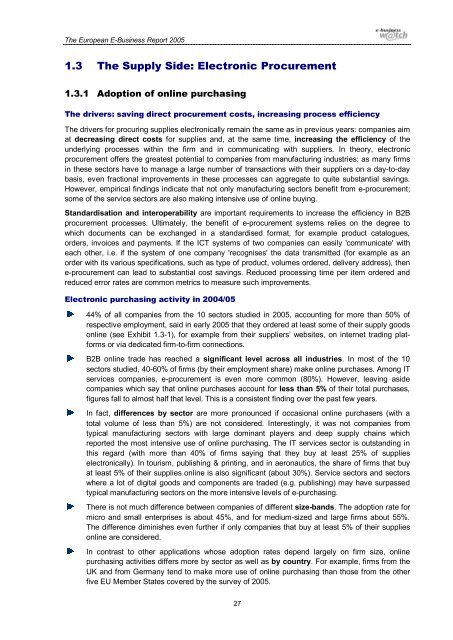The European e-Business Report The European e ... - empirica
The European e-Business Report The European e ... - empirica
The European e-Business Report The European e ... - empirica
You also want an ePaper? Increase the reach of your titles
YUMPU automatically turns print PDFs into web optimized ePapers that Google loves.
<strong>The</strong> <strong>European</strong> E-<strong>Business</strong> <strong>Report</strong> 2005<br />
1.3 <strong>The</strong> Supply Side: Electronic Procurement<br />
1.3.1 Adoption of online purchasing<br />
<strong>The</strong> drivers: saving direct procurement costs, increasing process efficiency<br />
<strong>The</strong> drivers for procuring supplies electronically remain the same as in previous years: companies aim<br />
at decreasing direct costs for supplies and, at the same time, increasing the efficiency of the<br />
underlying processes within the firm and in communicating with suppliers. In theory, electronic<br />
procurement offers the greatest potential to companies from manufacturing industries: as many firms<br />
in these sectors have to manage a large number of transactions with their suppliers on a day-to-day<br />
basis, even fractional improvements in these processes can aggregate to quite substantial savings.<br />
However, <strong>empirica</strong>l findings indicate that not only manufacturing sectors benefit from e-procurement;<br />
some of the service sectors are also making intensive use of online buying.<br />
Standardisation and interoperability are important requirements to increase the efficiency in B2B<br />
procurement processes. Ultimately, the benefit of e-procurement systems relies on the degree to<br />
which documents can be exchanged in a standardised format, for example product catalogues,<br />
orders, invoices and payments. If the ICT systems of two companies can easily 'communicate' with<br />
each other, i.e. if the system of one company 'recognises' the data transmitted (for example as an<br />
order with its various specifications, such as type of product, volumes ordered, delivery address), then<br />
e-procurement can lead to substantial cost savings. Reduced processing time per item ordered and<br />
reduced error rates are common metrics to measure such improvements.<br />
Electronic purchasing activity in 2004/05<br />
44% of all companies from the 10 sectors studied in 2005, accounting for more than 50% of<br />
respective employment, said in early 2005 that they ordered at least some of their supply goods<br />
online (see Exhibit 1.3-1), for example from their suppliers’ websites, on internet trading platforms<br />
or via dedicated firm-to-firm connections.<br />
B2B online trade has reached a significant level across all industries. In most of the 10<br />
sectors studied, 40-60% of firms (by their employment share) make online purchases. Among IT<br />
services companies, e-procurement is even more common (80%). However, leaving aside<br />
companies which say that online purchases account for less than 5% of their total purchases,<br />
figures fall to almost half that level. This is a consistent finding over the past few years.<br />
In fact, differences by sector are more pronounced if occasional online purchasers (with a<br />
total volume of less than 5%) are not considered. Interestingly, it was not companies from<br />
typical manufacturing sectors with large dominant players and deep supply chains which<br />
reported the most intensive use of online purchasing. <strong>The</strong> IT services sector is outstanding in<br />
this regard (with more than 40% of firms saying that they buy at least 25% of supplies<br />
electronically). In tourism, publishing & printing, and in aeronautics, the share of firms that buy<br />
at least 5% of their supplies online is also significant (about 30%). Service sectors and sectors<br />
where a lot of digital goods and components are traded (e.g. publishing) may have surpassed<br />
typical manufacturing sectors on the more intensive levels of e-purchasing.<br />
<strong>The</strong>re is not much difference between companies of different size-bands. <strong>The</strong> adoption rate for<br />
micro and small enterprises is about 45%, and for medium-sized and large firms about 55%.<br />
<strong>The</strong> difference diminishes even further if only companies that buy at least 5% of their supplies<br />
online are considered.<br />
In contrast to other applications whose adoption rates depend largely on firm size, online<br />
purchasing activities differs more by sector as well as by country. For example, firms from the<br />
UK and from Germany tend to make more use of online purchasing than those from the other<br />
five EU Member States covered by the survey of 2005.<br />
27

















